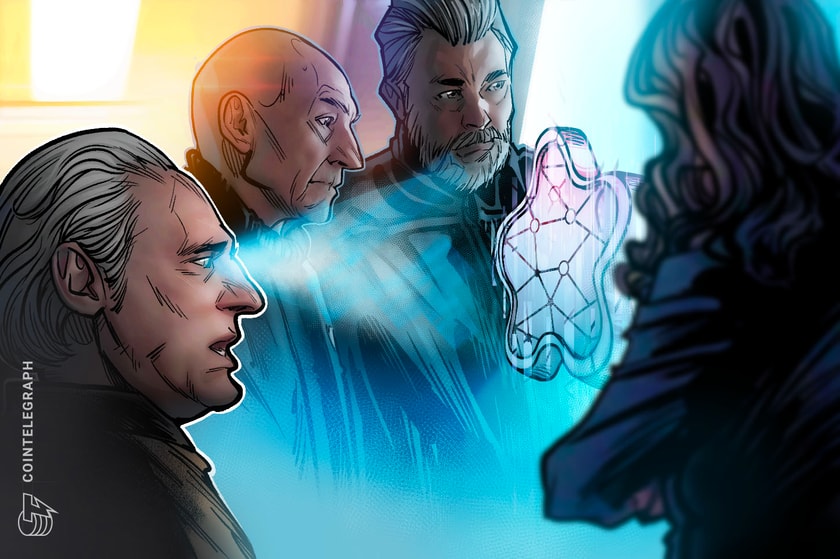Cryptocurrency
Are NFT markets in a death spiral or ready for a resurgence?

Nonfungible tokens (NFTs) saw a massive surge in popularity in 2021, accompanied by sky-high prices, but the market has since come crashing back to earth, and it’s unclear whether there will be a resurgence.
NFTs are unique digital tokens recorded on a blockchain to certify ownership and authenticity. They can’t be copied or substituted but can be transferred and sold by their owner.
According to analytics platform NFTGo, the NFT market cap valued in Ether (ETH) is down 40.59% over the past year at the time of writing, with trading volume down 40.81%.
The market cap in U.S. dollars is down 41.16%, and its volume has dropped 66.77%. At the same time, market sentiment is ranked 13 out of 100, with an overall rating of “cold.”

Arno Bauer, senior solution architect at BNB Chain, told Cointelegraph that from a utility perspective, NFT projects are increasingly adding value and that this growth in functionality is where the future of NFTs likely lies.
Bauer said the NFT market is showing “promising signs of innovation and creativity,” which holds great potential for the growth and evolution of the tech.
Related: Crypto lawyer about SEC: ‘Problematic to imply all NFTs are securities’
“Market sentiment, cultural shifts towards digital ownership, and the potential for NFTs to be integrated into various aspects of our lives also contribute to a positive outlook for the future of NFTs,” he said.
“While current market conditions might seem subdued, the ongoing innovation and potential for integration with both digital and physical worlds suggest that NFTs have not had their day and that their continued relevance and growth are highly probable,” Bauer added.
NFTs in the long term
As for long-term use cases, Bauer said NFTs will “likely evolve” over time and become increasingly linked to real-world assets, such as property ownership or unique physical goods.
Currently, NFTs have been most successful in the art world, with some selling for tens of millions of dollars.

Digital artist Pak sold an NFT project titled “The Merge” for $91.8 million on Nifty Gateway in 2021, while Mike Winkelmann, also known as Beeple, sold “Everydays: The First 5000 Days” for $69.3 million via Christie’s auction house the same year.
Blockchain games also use NFTs to represent in-game items such as weapons and armor, and there is speculation the tech will make the jump to mainstream games. Various types of music assets are also being sold as one-of-a-kind NFTs.
Bauer thinks that as more robust technology provides enhanced use cases and ownership security, NFTs will likely become more attractive to mainstream markets.
He speculated that NFTs could link to financial instruments, representing shares in companies or investment funds, and social achievements, where they could symbolize badges of accomplishment in various fields.

“Beyond art, the ability to tokenize unique assets and provide verifiable ownership will create numerous applications across various domains,” Bauer said.
“Collaborations with traditional industries, technological advancements, clear regulatory frameworks and educational efforts can significantly boost NFT utility and adoption.”
“Addressing sustainability concerns could make them more appealing to a broader audience,” he added.
NFTs have the potential to make a comeback
Jason Bailey, co-founder and CEO of NFT tool and self-custody solution ClubNFT, told Cointelegraph he thinks “NFTs will come back and go mainstream” because crypto and NFTs rebound cyclically, just like previous tech crashes.
According to data gathering platform Statista, the NFT market is projected to continue growing in revenue, users and market capitalization.
As of 2023, there are 13.95 million NFT users, but that’s expected to hit 19.31 million users by 2027.

However, Bailey believes NFTs currently have some issues, most of which were amplified by rampant market speculation, that need to be solved before NFTs can go mainstream.
He said NFTs and the ecosystem around them are so complex that almost everyone is still vulnerable to many risks they may not even know about.
“Many of us have been trying to educate and onboard people into the space thoughtfully so they can be safe, but the truth is that NFTs won’t go mainstream until the complexity is replaced with a safe-by-default easy path,” Bailey said.
“For example, the vast majority of people don’t realize that an NFT is almost always at risk in a sense, except for fully on-chain NFTs, which are a truly tiny fraction.”
“The steps needed to protect the art from disappearing, and prevent the NFT from breaking, are complicated, time-consuming and error-prone,” he added.
Related: AI-based tools bring security and transparency to the NFT market
Bailey believes that in the long term, NFTs or similar tech could prove invaluable in validating digital documents such as marriage certificates, diplomas and licenses.
Overall, he thinks NFTs solve too many of the current problems associated with digital ownership — including scarcity, authentication, provenance and provable ownership — to be ignored.
“We need to build infrastructure now, during the bear market, for smoother onboarding and to protect NFT adopters from malicious actors in the next NFT bull market,” he said.
“Once these issues are solved, NFTs will absolutely go mainstream because the train of digital ownership left the station decades ago, and there is no stopping it.”
Meaningful projects could be a game changer for NFTs
Speaking to Cointelegraph, Andy Ku, founder and CEO of digital content Web3 ecosystem Altava Group, said he thinks the previous highs in the NFT market were based on a hype cycle, so it’ll be hard for an individual NFT to reach such lofty heights again.
asked google bard to write me some tweets about NFT market right now…
mf really went for the throat on these… pic.twitter.com/aLjUbwH3gT
— beeple (@beeple) August 22, 2023
According to CoinGecko, many of the top NFT collections have seen significant drops in value over the past year.
At the time of writing, Bored Ape Yacht Club has fallen by 67.1%, CryptoPunks by 33.2%, Mutant Ape Yacht Club by 59.2% and Azuki by 49.3%.
Ku believes that if we can see more meaningful NFT projects on the market offering tangible benefits to more people, then it’s possible to have the combined volume bring the overall market value up.
Related: What’s next for NFTs and Web3 in the age of the creator economy?
“NFTs should offer value and utility beyond just a digital art or PFP. The two areas I particularly believe in are asset-backed NFTs and a membership NFT,” he said.
“NFT’s core value of being an immutable representation of something is a great fit for assets and membership.”
NFTs for subscription, membership-based models and loyalty programs are starting to gain traction, with examples in hospitality venues and gyms already on the market.
“In terms of asset-backed NFTs, master artworks, real estate and precious metals like gold are all good examples of assets in which people believe,” Ku said.
“NFTs would make a great proof-of-ownership for these assets as well as being extremely portable,” he added.
Cryptocurrency
Ethereum Foundation, Whales, and Hackers: What’s Driving the ETH Sell-Off?

TL;DR
- Whales, hackers, and the Ethereum Foundation wallets moved over $500M in ETH through large sales and withdrawals.
- Ethereum transfers rose to 4.6M ETH, nearing the monthly high of 5.2M recorded in July.
- Staking inflows hit 247,900 ETH, the highest in a month, locking more supply from trading.
Large Withdrawals and Whale Activity
Ethereum (ETH) has seen heavy movement from major wallets over the past few days. On-chain data from Lookonchain shows a newly created wallet pulled 17,591 ETH, worth $81.62 million, from Kraken in just two hours.
Over three days, two new wallets withdrew a combined 71,025 ETH, valued at $330 million, from the exchange.
One of these wallets, address 0x2A92, has withdrawn 53,434 ETH, worth $242.34 million, in two days. This includes a recent purchase of 30,069 ETH, valued at $138.46 million, during a market drop.
Major ETH Holders Offload Millions Amid Price Rally
In contrast, several separate entities have been disposing of some ETH holdings. A wallet tied to a hacker address 0x17E0 sold 4,958 ETH for $22.13 million at $4,463, securing a profit of $9.75 million. Earlier this year, the same address sold 12,282 ETH at $1,932 and later bought back part of the amount at higher prices.
A different whale sold 20,600 ETH for $96.55 million over the past two days, generating a profit of more than $26 million after holding the position for nine months.
Meanwhile, an Ethereum Foundation-linked wallet, 0xF39d, sold 6,194 ETH worth $28.36 million in the last three days at an average price of $4,578.
Recent sales from the same wallet included an additional 1,100 ETH and 1,695 ETH for over $12.7 million combined.
The #EthereumFoundation-linked wallet(0xF39d) sold another 1,300 $ETH($5.87M) at $4,518 ~11 hours ago.
Over the past 3 days, this wallet has sold a total of 6,194 $ETH($28.36M) at an average price of $4,578.https://t.co/4hfCWymHVG pic.twitter.com/ErUyEY8SJy
— Lookonchain (@lookonchain) August 15, 2025
Network Activity on the Rise
CryptoQuant data shows Ethereum’s total tokens transferred have been climbing since August 9. After ranging between 1 million and 3 million ETH through late July and early August, transfers have risen to 4.6 million ETH, approaching the monthly high of 5.2 million recorded in mid-July. This increase has occurred alongside a price rally from about $3,400 to $4,600.
Interestingly, staking inflows generally stayed between 20,000 and 80,000 ETH per day over the past month. On August 14, inflows jumped to 247,900 ETH, the highest in the period.
At the time, ETH was trading near $4,600. Large staking deposits reduce the amount of ETH available for immediate trading, as staked coins are locked for a set period.
In the meantime, ETH trades at $4,647 with a 24-hour volume of $68.25 billion, down 2% on the day but up 19% over the week.
Binance Free $600 (CryptoPotato Exclusive): Use this link to register a new account and receive $600 exclusive welcome offer on Binance (full details).
LIMITED OFFER for CryptoPotato readers at Bybit: Use this link to register and open a $500 FREE position on any coin!
Cryptocurrency
Massive DOGE Whale Activity Hints at $1 Breakout

TL;DR
- Whales bought two billion DOGE this week, lifting their combined holdings to 27.6 billion coins.
- A single 900M DOGE transfer worth $208M to Binance drew attention to large exchange movements.
- DOGE broke key resistance, with momentum building for a possible push toward the $1 price mark.
Price and Market Moves
Dogecoin (DOGE) traded at $0.23 at press time, slipping 4% over the past day but still showing a 2% gain for the week. Daily turnover came in at about $6.18 billion.
Meanwhile, the broader crypto market saw over $1 billion in liquidations. Hotter-than-expected US Producer Price Index data pushed traders to scale back expectations of a near-term Federal Reserve rate cut. DOGE had roughly 290,500 coins liquidated during the sell-off.
On the two-week chart, analyst Trader Tardigrade notes that DOGE has cleared a downward-sloping resistance line after completing what appears to be a “wave V” in an Elliott Wave sequence. Similar setups in the past, where prolonged declines stayed within falling channels before breaking higher, have been followed by sharp rallies.
$Doge/2-week#Dogecoin is gaining strong momentum to surge above $1 pic.twitter.com/TuSEKr19nv
— Trader Tardigrade (@TATrader_Alan) August 15, 2025
Momentum gauges are also turning up. The Stochastic RSI, which had dropped into oversold territory, is now heading higher. Previous reversals from this zone have coincided with sustained upward moves. The current formation points to a possible run that could carry DOGE past the $1 mark.
Heavy Whale Buying and Large Transfers
As reported by CryptoPotato, blockchain data shows large investors have added two billion DOGE in the past week, spending just under $500 million. That brings their holdings to about 27.6 billion coins, or 18% of the supply. The buying streak has prompted speculation within the community.
Recently, Whale Alert flagged a 900 million DOGE transfer worth about $208 million into Binance. The tracking indicates that it originated from a wallet connected to the exchange, likely as an internal activity. The address involved holds 2.88 billion DOGE, one of the largest balances on the network.
Ali Martinez also reports that transactions above $1 million reached a one-month high, with activity building since early August and peaking as DOGE traded at $0.25.
Whales are back! Dogecoin $DOGE activity at a 1-month high. pic.twitter.com/C83Pv68mCt
— Ali (@ali_charts) August 14, 2025
Sentiment Building
Analyst Gordon described the current setup as “a nice bit of consolidation” before a potential breakout, adding,
“This will be one of the first coins normies FLOCK to & the pump will be MASSIVE.”
With whale accumulation rising, high-value transfers increasing, and a bullish technical pattern in play, DOGE is positioned for a potential push toward $1 if momentum holds.
Binance Free $600 (CryptoPotato Exclusive): Use this link to register a new account and receive $600 exclusive welcome offer on Binance (full details).
LIMITED OFFER for CryptoPotato readers at Bybit: Use this link to register and open a $500 FREE position on any coin!
Cryptocurrency
Ripple Price Analysis: XRP at Risk as Key Support Levels Could Trigger Sharp Drop

XRP has recently entered a consolidation phase after a strong rally earlier this summer, with the price action now hovering around key resistance levels on both its USDT and BTC pairs. Yet, while momentum has slowed, the charts still indicate a generally bullish structure, with multiple key support levels remaining firmly in place.
Technical Analysis
By ShayanMarkets
The USDT Pair
On the XRP/USDT daily chart, the price is currently trading near the $3.10 mark, facing a strong resistance zone around $3.40. This follows a breakout above the $2.70 range in July, which has now flipped into a support area.
Both the 100-day and 200-day moving averages are also trending upward and recently formed a bullish crossover around $2.45, reinforcing the medium-term bullish sentiment. If the $3.40 resistance breaks, a push toward the critical $4.00 range becomes likely.
However, the RSI hovering near the neutral 50 level suggests a lack of strong momentum for now, meaning a short-term pullback into the $2.80 support zone is still possible.
This zone will be key for maintaining the bullish structure. Losing it could open the door for a deeper correction toward the 200-day moving average located around the $2.40 mark. Yet, as long as the price stays above the moving averages, the broader trend remains bullish.
The BTC Pair
Looking at the XRP/BTC chart, the pair has recently pulled back after hitting the 3,000 SAT resistance, with the price currently around 2,600 SAT.
This follows a clean breakout above the long-term descending channel and a successful retest of its upper boundary, which coincided with the 200-day moving average and the 2,400 SAT support zone. This confluence remains a key bullish technical factor, as holding above it could attract renewed buying pressure.
That said, RSI levels around 48 show that momentum has cooled after the sharp July rally, meaning XRP may continue ranging between 2,400 SAT and 3,000 SAT in the near term. A decisive close above 3,000 SAT would likely open the path to the 3,400 SAT zone, while losing 2,400 SAT could shift the bias back toward 2,000 SAT support. For now, the structure still favors the bulls as long as higher lows remain intact.
Binance Free $600 (CryptoPotato Exclusive): Use this link to register a new account and receive $600 exclusive welcome offer on Binance (full details).
LIMITED OFFER for CryptoPotato readers at Bybit: Use this link to register and open a $500 FREE position on any coin!
Disclaimer: Information found on CryptoPotato is those of writers quoted. It does not represent the opinions of CryptoPotato on whether to buy, sell, or hold any investments. You are advised to conduct your own research before making any investment decisions. Use provided information at your own risk. See Disclaimer for more information.
Cryptocurrency charts by TradingView.

 Forex3 years ago
Forex3 years agoForex Today: the dollar is gaining strength amid gloomy sentiment at the start of the Fed’s week

 Forex3 years ago
Forex3 years agoUnbiased review of Pocket Option broker

 Forex3 years ago
Forex3 years agoDollar to pound sterling exchange rate today: Pound plummeted to its lowest since 1985

 Forex3 years ago
Forex3 years agoHow is the Australian dollar doing today?

 Cryptocurrency3 years ago
Cryptocurrency3 years agoWhat happened in the crypto market – current events today

 World3 years ago
World3 years agoWhy are modern video games an art form?

 Commodities3 years ago
Commodities3 years agoCopper continues to fall in price on expectations of lower demand in China

 Economy3 years ago
Economy3 years agoCrude oil tankers double in price due to EU anti-Russian sanctions

























